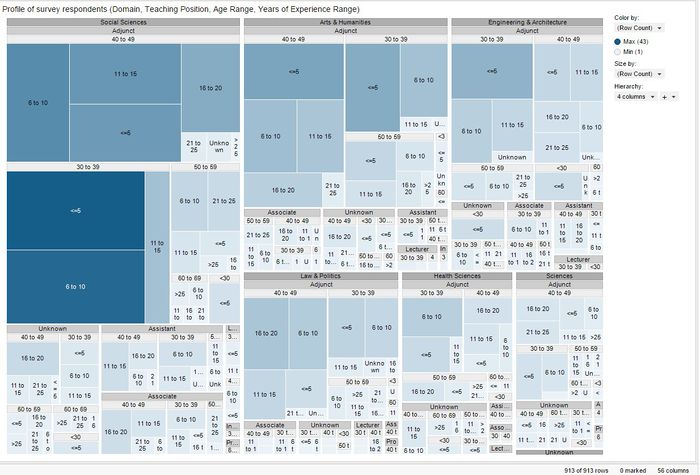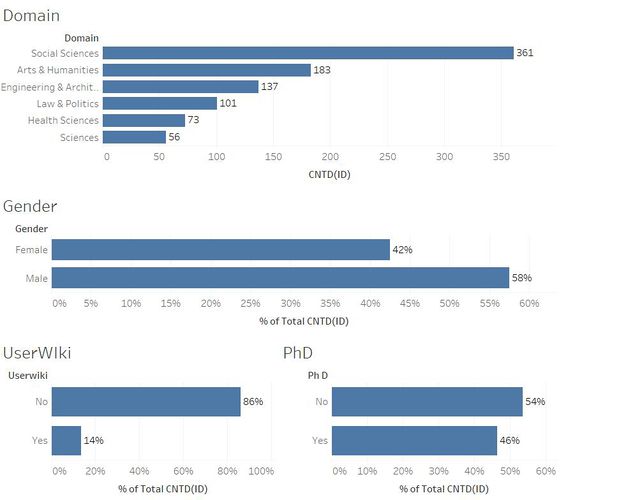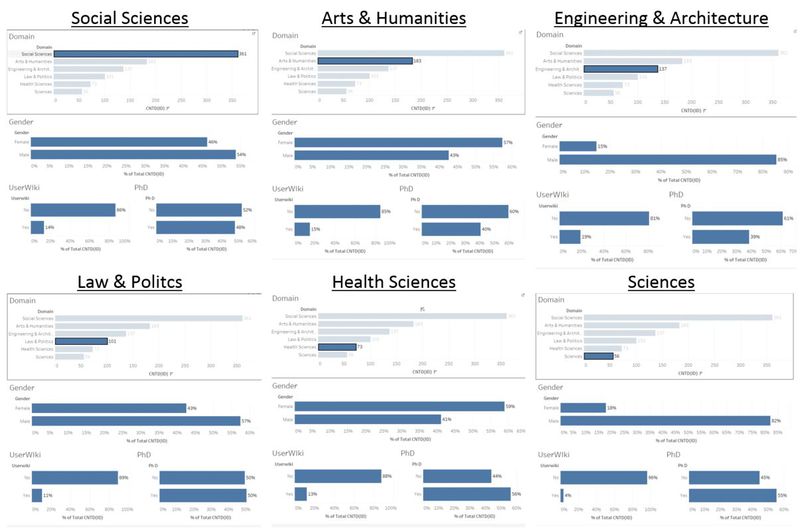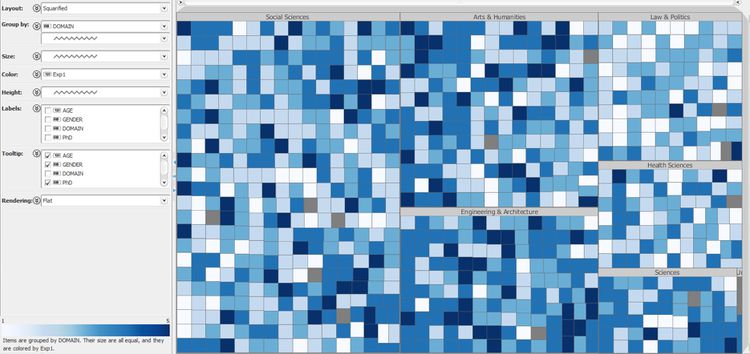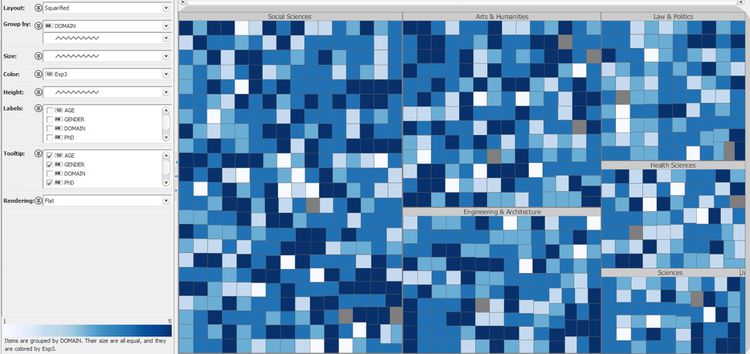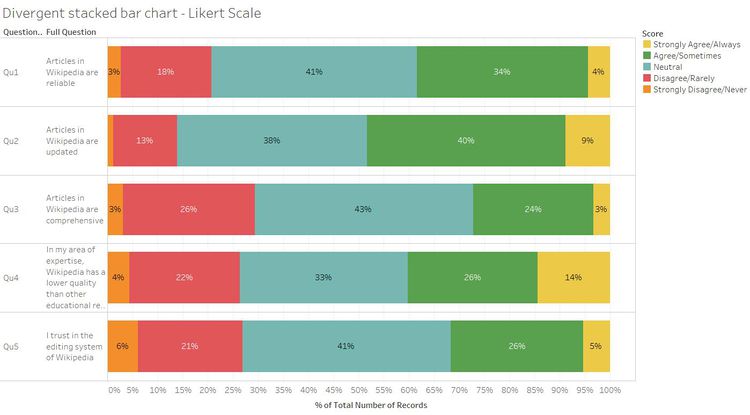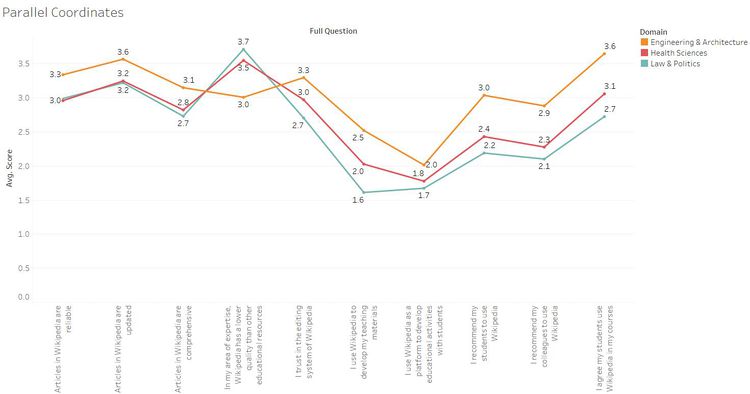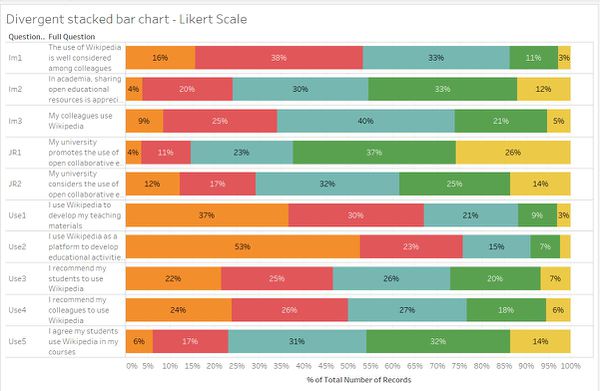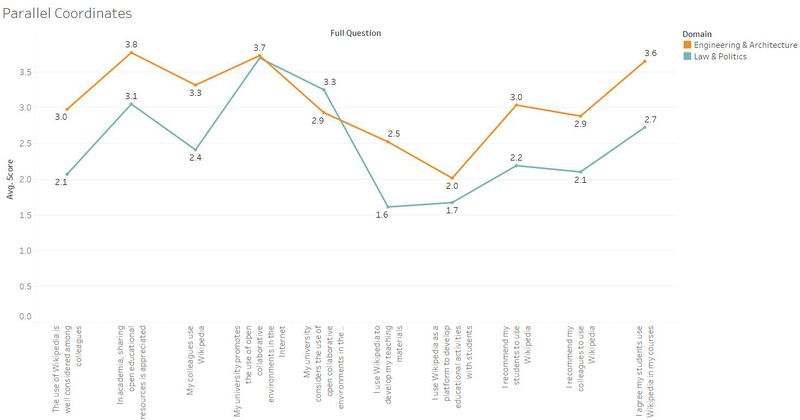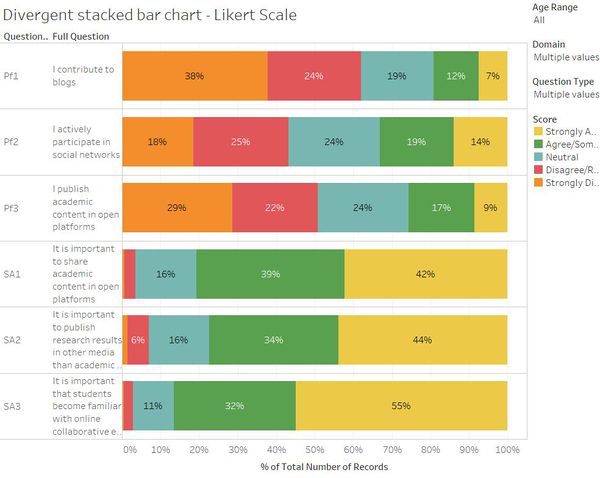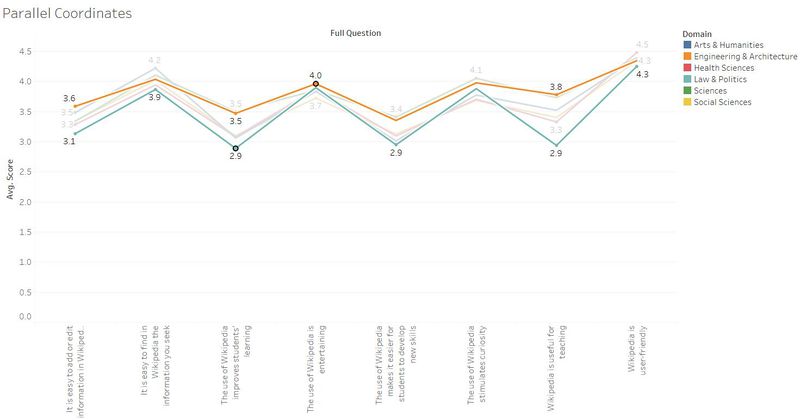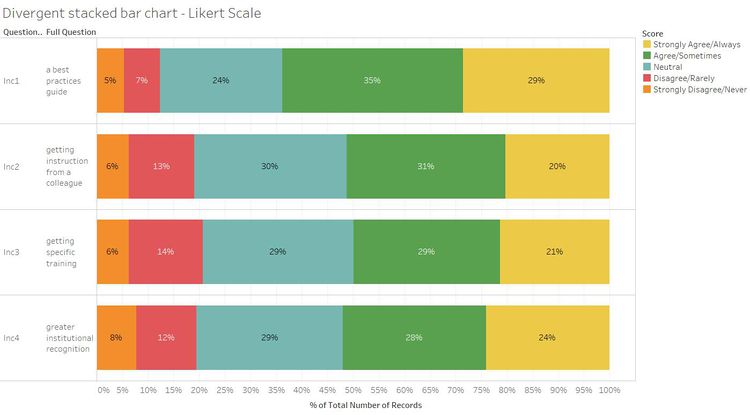ISSS608 2016-17 T1 Assign2 Alvin Yuen
Contents
- 1 Abstract
- 2 Data Source
- 3 Data Preparation
- 4 Profile of Survey Respondents
- 5 Survey Results
- 6 Perception of Quality on usage of Wikipedia in Higher Learning
- 7 What is the social image and university sentiments on Wikipedia for higher learning?
- 8 How active are the faculty members in contributing to internet sharing platform? What are their sentiments towards open source online platform
- 9 What are the perception of the respondents of Wikipedia in terms of Usefulness, Convenience and Enjoyment?
- 10 Key Factors
- 11 Incentives to use Wikipedia
- 12 Tools Utilization
Abstract
Wikipedia is one of the most common online resource which students rely upon to seek answers for academia and non-academia queries, in this study the attitude of the faculty members from two Spanish Universities, Universitat Oberta de Catalunya (UOC) and UCF were studied to assess the sentiments of the faculty members to the usage of Wikipedia for Higher Learning, specifically the sentiments of the faculty members would be studied based on the teaching domain they are in.
Data Source
The data was obtained from the UCI Machine Learning Repository [[2]], the dataset originated from a research on "Factors that influence the teaching use of Wikipedia in Higher Education" by E. Aibar, J. Lladós, A. Meseguer, J. Minguillón (jminguillona[at]uoc[dot]edu), M. Lerga. Universitat Oberta de Catalunya, Barcelona, Spain.
Data Preparation
Cleaning of Raw Dataset
- The raw dataset contains numeric values for the categorical variables which might not be intuitive when used for analysis, the numbers are coded according to the documentation provided in UCI, values which could not be classified in the categories provided are coded as unknown.
- The age of the faculty members and their years of experience are binned into groups, age and years experience are categorised into a defined range.
- The Question Type and Full Question are added to the dataset to allow for better visualization in Tableau.
Transformation of Dataset
An ID was assigned according to the row number of the rows, after which the dataset is stacked using JMP accoding to the survey questions which involves a Likert Scale.
Profile of Survey Respondents
Before reviewing the survey results, we could first take a look at the profile of the respondents of the survey. The treemap on the left is constructed based on the hierarchy of Domain, followed by the respondent's teaching position, age range and lastly years of experience.
- As can be observed, most of the faculty members were from Social Sciences, followed by Arts & Humanities, Engineering & Architecture, Law & Politics, Health Science and Sciences
- Adjunct Professor is the most common teaching position amongst all faculties
- The common age range of the respondents are in the 30 to 49 years old range
- Overall the majority of the respondents are non-Wikipedia registered user (86%), the non-Wikipedia registered user is constantly over 80% for all domain types.
- The overall male and female distribution is at quite an equal distribution of 58% male and 42% female, this is true for most domains, except for Engineering & Architecture and Sciences where the majority of the respondents are male, 85% for Engineering & Architecture and 82% for Sciences.
- There is quite an equal distribution of PhD holders and non-PhD holders at 54% (non-PhD) vs 46% (PhD), the distribution is quite consistent for all domains except for Engineering & Architecture (61% non-PhD and 39% PhD) and Arts & Humanities (60% non-PhD and 40% PhD)
Survey Results
Likert Scale Survey Questions

- The divergent stacked bar chart allow quick visualization of the different responses which the respondents have towards each question. The filter on the right includes domain, question type, age range, the years of experience, and teaching position. The dashboard helps in providing understanding of the respondents' sentiments based on the topic of interest, for example I may be concern with the experience of the respondents with Wikipedia and their use behaviour of Wikipedia, I would then proceed to filter out these questions using the Question Type filter bar to review the responses.
Please refer to interactive dashboard at the following url: https://public.tableau.com/profile/publish/Wiki4HE_LikertScaleSurveyResults/Dashboard1#!/publish-confirm
What is the adoption status of Wikipedia of the respondents like?
- Before trying to understand the factors which would influence the usage of Wikipedia in Higher Learning for the respondents, we could first understand the Wikipedia adoption status of the faculty members. The chart on the left shows the response of all the faculty members in terms of their past use behaviour and personal experiences with Wikipedia.
- Based on the responses of the faculty members to the questions on Experience, it can be inferred that they are not really relying on Wikipedia extensively for teaching in school. From the replies to question Exp5, it can observed that 55% of the respondents rarely or never use Wikipedia to work with their students and only about 28% of the respondents used Wikipedia sometimes (19%) and always (9%) to work with their students. In addition, the response of the faculty members to question Use1 and Use2 is overwhelmingly low for developing their teaching materials (67% responded to have never or rarely utilised Wikipedia for teaching materials) and as a platform for development of educational activities with students (51% responded to have never and 24% responded as to rarely).
- In fact, the faculty themselves are not regular contributors to Wikipedia, as can be seen in question Exp4, where 64% of the faculty members never contributed to Wikipedia and 20% rarely contribute to it, only about 6% of the faculty members would sometimes or always contribute to Wikipedia.
- However, this does not mean that the faculty members has a lack of personal experiences or trust in Wikipedia materials. As they do consult Wikipedia for academic related issues, about 53% responded that they sometimes (36%) or always (17%) consult Wikipedia for academic related issues. The figure is slightly higher for the use of Wikipedia for consultation of personal issues, about 61% responded that they sometimes (38%) and always (23%) consult Wikipedia for personal issues. They also did not show signs of disagreement on the usage of Wikipedia by the students for their courses, only about 23% show signs of disagreement according to question Use5, while most of the faculty members are either neutral (32%) or accepting of it (45%).
What about the adoption status based on Teaching Domain?
The colour intensity move from white to dark blue as ratings changes from strongly disagree/never to strongly agree/always
- Treemap allow the visualization of the differences in opinions of faculty members to the usage of Wikipedia based on their teaching domains.
- As can be observed from the Treemap on the left where the overall colour intensity of the Law & Politics and Health Sciences are the lightest among all domain types. Faculty members from Law & Politics and Health Sciences responded less favorably towards the consultation of Wikipedia for issues which are related to their field of expertise relative to the faculty members from Engineering & Architecture and Arts & Humanities.
- Does the faculty members from Law & Politics and Health Sciences uses Wikipedia for other purposes other than for their field of expertise? Yes they do rely on Wikipedia for information for their personal issues, as can be seen in the Treemap on the right, the colour intensity in the two faculties are visibly darker and more in line with the rest of the teaching domains. This suggest that the faculty members from Law & Politics and Health Sciences responded more favorably towards the usage of Wikipedia for subjects not related to their domains in the survey.
- The above observations can be reflected in their use behaviour on Wikipedia, as can be seen above the faculty members from Law & Politics and Health Sciences has a lighter shade of blue for both Treemaps, this shows that it would be less likely that they will recommend Wikipedia to their students in comparison to faculty members from other domain types. They are also less agreeable to the use of Wikipedia by their students in their courses.
Perception of Quality on usage of Wikipedia in Higher Learning
- Overall, the faculty members responses to the questions on the quality of the Wikipedia articles are relatively neutral.
- However it can be noted that 40% of the respondents felt that Wikipedia has a lower quality than other educational resources. While the sentiments towards the timeliness of Wikipedia was also relatively high at 49%.
Parallel Coordinates Plot of Quality and Use Behaviour
- The average scores on quality and use behaviour of each domain types are plotted in the form of a parallel coordinate plot to try to investigate the reason for the lower adoption of Wikipedia by the Law & Politics and the Health Sciences Faculty members, this is shown in the two charts above.
- On average the Law & Politics and Health Sciences faculty members felt quite strongly (3.7 out of 5) that in their areas of expertise Wikipedia offers a lower quality than other educational resources which they could tap on.
- The faculty members from Law & Politics and Health Sciences also rated the reliability, comprehensiveness, timeliness and trust in editing system of Wikipedia less favourably than their colleagues in Engineering & Architecture.
- This is reflected in the likelihood to recommend Wikipedia to their students and acceptance of usage of Wikipedia by their students, as on average the members from Engineering & Architecture rated higher for these aspects than the Law & Politics and Health Sciences faculty members.
- This suggests that the perception on quality did have a correlation with how likely the faculty members would use, recommend and accept the usage of Wikipedia as a platform for higher learning.
What is the social image and university sentiments on Wikipedia for higher learning?
- One could observe that the majority of the faculty members do not agree that Wikipedia is well considered among their colleagues (54%), only 14% of the respondents seems to agree that Wikipedia is well considered among their peers.
- There are more faculty members who appreciate the sharing of open educational resources in academia (45%) than those who disagree (24%). The faculty members also largely agree that their universities promotes the usage of open collaborative environments in the internet (63%).
- The two observations above suggests that firstly the faculty members would welcome open source education platform, their universities also promotes the usage of such platform but faculty members are relatively apprehensive on whether their colleagues would consider Wikipedia as a well regarded open environment. This may hinder their readiness to embrace the usage of Wikipedia to develop teaching materials and for development of educational activities for their students.
- It could be observed that between Engineering and Architecture and Law & Politics, there was quite a contrast between their views on the social image of Wikipedia and open educational resources.
- The use of Wikipedia appeared to be more well regarded among Engineering & Architecture (3.0) compared to Law & Politics (2.1), more of the faculty members from Engineering & Architecture also seems to think that their colleague uses Wikipedia (3.3 to 2.4). Faculty members from Engineering & Architecture (3.8) also seems to appreciate the sharing of open educational resources more than Law & Politics. (3.1).
How active are the faculty members in contributing to internet sharing platform? What are their sentiments towards open source online platform
- Overall, the faculty members do not really participate in sharing of contents online in terms of blog (62% does not) and academic content in open platforms (51% does not).
- However despite most of the faculty members being inactive contributors to the internet, most of the faculty members displayed positive sentiments towards the importance of adopting a sharing attitude in open collaborative platforms. This can be observed in the divergent bar chart above where the majority of the respondents over 75% agreeing on importance of adopting a sharing attitude online.
- These sentiments and internet profiles do not deviate much among the different domains as can be seen in the parallel coordinate plot above.
What are the perception of the respondents of Wikipedia in terms of Usefulness, Convenience and Enjoyment?
- Based on the faculty members to the question on the ease of use, it could be observed that while the members felt that it is easy to navigate (84% felt that it is user friendly) and use Wikipedia to search for information (77% felt so), the ratings for ease of usage in terms of editing or adding of information dropped quite significantly (only 43% felt that it is easy).
- When evaluating the average score given for these questions based on domain types, it can be observed that the faculty members from Law & Politics rate the the use of Wikipedia improves students' learning and that Wikipedia is useful for teaching the lowest.
Key Factors
The following are some factors which may suggest why the adoption of Wikipedia is relatively low among the faculty members:
- Peer Influence - Faculty members responded that Wikipedia is not that well regarded as a learning platform among colleagues.
- Ease of editing - In comparison to the user friendliness and ease in sourcing of information, the ratings for ease of editing were considerably lower. Hence increasing the ease of usage in terms of editing and adding information would be useful to encourage more faculty members to explore the usage of Wikipedia as a teaching platform.
- Quality - 40% of the faculty members agreed that in their area of expertise, Wikipedia has a lower quality than other educational resources. This perception may have swayed the faculty members to adopt other resources other than Wikipedia when sourcing for information.
Why is the adoption of Wikipedia low among Law & Politics faculty members relative to other domains?
- Trust in quality of articles - Law & Politics faculty members' responses average ratings were the lowest among all domains in terms of quality. They also displayed the least trust in Wikipedia in comparison to other educational resources which they had.
- Peer Influence - Law & Politics gave the lowest ratings for the use of Wikipedia amongst their colleagues (2.1 for well regardness and 2.4 for usage by colleagues).
- Usefulness - The average scores given by Law & Politics faculty members were quite significantly lower than the rest of the domains in terms of usefulness in teaching.
Incentives to use Wikipedia
- Of the suggested incentives provided in the survey, faculty members rated a best practices guide the highest (64% agree/strongly agree). As most of the faculty members had reflected difficulty in editing or adding contents to Wikipedia, having a best practice guide could aid in increasing the ease of usage and uptake.
Tools Utilization
- Tableau 10.0
- TIBCO Spotfire
- Macrofocus Treemap
- JMP Pro

